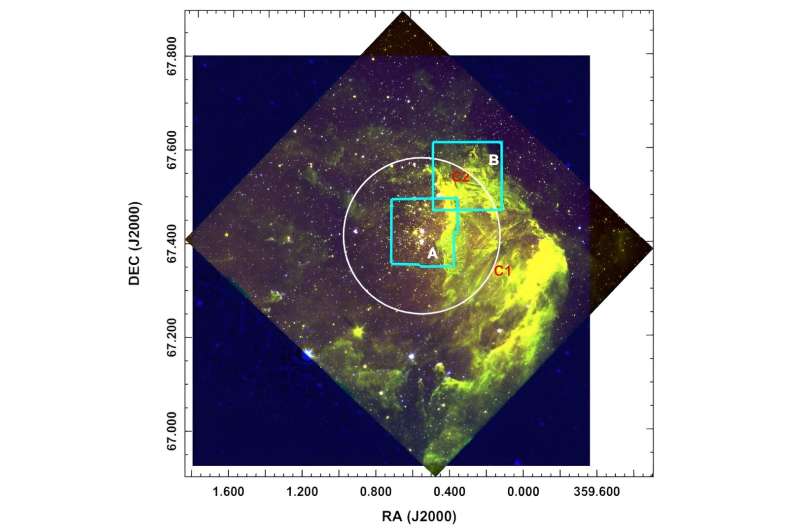June 19, 2024 report
This article has been reviewed according to Science X's editorial process and policies. Editors have highlighted the following attributes while ensuring the content's credibility:
fact-checked
preprint
trusted source
proofread
Observations explore stellar content of nearby young open cluster Berkeley 59

Astronomers from India and Thailand have observed a young nearby open cluster known as Berkeley 59. Results of the observational campaign, published June 12 on the pre-print server arXiv, deliver essential information regarding low-mass stellar and substellar content of this cluster.
Open clusters (OCs), formed from the same giant molecular cloud, are groups of stars loosely gravitationally bound to each other. So far, more than 1,000 of them have been discovered in the Milky Way, and scientists are still looking for more, hoping to find a variety of these stellar groupings.
Expanding the list of known galactic open clusters and studying them in detail could be crucial for improving our understanding of the formation and evolution of our galaxy.
Berkeley 59 is a 2-million-year old Galactic OC located some 3,300 light years away, in the Cepheus OB4 stellar association. It contains several massive stars associated with natal molecular clouds, which makes it one of the potential nearby massive clusters.
Previous studies of Berkeley 59 were limited to the high and intermediate-mass stars only, hence the cluster's low-mass stellar content is still poorly understood. That is why a team of astronomers led by Neelam Panwar of the Aryabhatta Research Institute of Observational Sciences (ARIES) in India decided to investigate the lowest mass members of Berkeley 59.
"We present a multi-wavelength analysis of the young star cluster Berkeley 59 based on the Gaia data and deep infrared (IR) observations with the 3.58-m Telescopio Nazionale Galileo and Spitzer space telescope," the researchers wrote in the paper.
The observations conducted by Panwar's team are the deepest to date for Berkeley 59 and its surroundings. The astronomers managed to assess the stellar contents of Berkeley 59 down to the hydrogen burning limit (about 0.075 solar masses), and shed more light on the cluster's properties.
The study found that the initial mass function of the central portion of Berkeley 59, in the mass range 0.04–0.4 solar masses, is 0.01. This result is similar to the values obtained for nearby young star-forming regions.
Furthermore, it turned out that the spatial distribution of young brown dwarfs and stellar candidates in the investigated cluster shows a non-homogeneous distribution. According to the astronomers, this suggests the significance of radiation feedback from massive stars in the formation of brown dwarfs in Berkeley 59.
The collected data regarding the distribution of stellar and brown dwarf candidates in Berkeley 59 indicate that these two populations significantly differ, and stellar candidates are closer to the cluster center when compared to brown dwarfs. The researchers conclude that this result suggests mass segregation in the cluster toward the substellar mass objects.
The study also found that the star-to-brown dwarf ratio for Berkeley 59 is at a level of 3.6, and that mean proper motion of the cluster is -0.63 and -1.83 mas/year in right ascension and declination, respectively.
More information: Neelam Panwar et al, Low-mass stellar and substellar content of the young cluster Berkeley 59, arXiv (2024). DOI: 10.48550/arxiv.2406.08261
Journal information: arXiv
© 2024 Science X Network





















